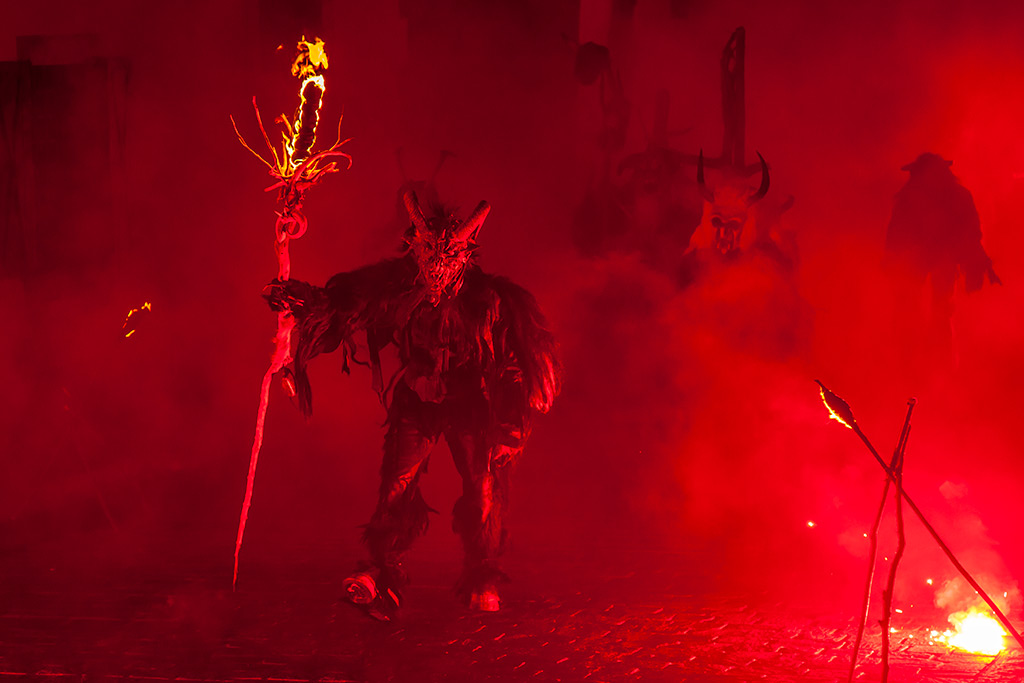EXPERIENCING TRADITIONS IN VALCANALE IS LIKE BEING A CHILD AGAIN…
Fascinating rituals and customs, which have been handed down from father to son to the present day, fill the Valcanale calendar.
These events involve local families and visitors who want to experience them just as they used to be.
SAN NICOLO’ AND THE KRAMPUS
At dusk on December 5, they descend from the mountains and come out of the woods, devilish creatures, wild spirits, called Krampus.
They accompany San Nicolò, the good saint, whose task it is to keep them at bay
San Nicolò calls the children one by one, asks them for a prayer and to promise to be good in exchange for a small gift.
The Krampus, meanwhile, are up against the meanest young men, while waiting for them in the squares of the villages of Malborghetto, Tarvisio, Tarvisio Centrale, Loc.
Rutte Grande and Pontebba there are shows, vin brûlé (warm wine) kiosks, hot and sweet drinks.
San Nicolò and the Krampus are fascinating traditions for the local population and tourists who come from afar.

“BRINA” OR “SCIAPA”
The boys of Ugovizza who have come of age during the year gather on December 27 and, passing from house to house, show themselves to the community, bringing a branch of white fir, known as brina or sciapa, accompanied by a good year’s greeting.
It is customary for the master of the house to leave a tribute to the boys, which will serve for the organization of their party.
The group is accompanied by a spontaneous chorus of men singing “Hoch sollst du leben”.

SCIP SCIAP
On December 28, the children of Ugovizza and Valbruna wander the village streets in search of the legs of adults to be thrashed with a small spruce branch. They recite an auspicious nursery rhyme in Slovenian or German “so many needles are present on this branch, as the years of health and joy we wish you”. In return, they get a few pennies… in the past, they used to receive nuts and bread.

PECHTRA BABA
On the eve of epiphany, gloomy sounds echo along the streets of Ugovizza, Camporosso and Malborghetto.
The town children’s candid souls drive away the evil spirit of the Pechtra Baba using cowbells.
This character may have negative influences on agricultural production and must, therefore, be driven out.
It is usually a kind of raggedy Befana (witch), often impersonated by a local boy.

THE THREE KINGS
On January 6, the children of the town dress up in the robes’ of the three wise men.
They go from house to house, singing the happy news and collecting an offer.
Leaving the house, a child writes with chalk on the door jamb the first two digits of the year, the letters KMB or GMB interspersed with crosses and the last two digits of the year (e.g., 20 K+M+B 19).
The letters are the initials of the names of the three kings:
Kaspar (in German) or Gaspar (in Slovene), Melchiorre and Baldassarre.

RITUALS LINKED TO EASTER
Palm Sunday is the day of the blessing of Prajtl/Palbusch, a branch composed of various plant species enriched with sweets and bows.
After being blessed, the Prajtl is placed among the beams of the roofs, is planted in a field or is crumbled in the animal feed… to bless things dear to the agricultural population.
Between Holy Thursday and Saturday, the village children mark the time and call the population to mass using the raganelle (wooden rattles).
It is said that the bells flew to Rome and were substituted by rattles.
In the towns of San Leopoldo, Malborghetto, Ugovizza, Valbruna, Camporosso and Fusine the Holy Sepulchres are set up. They are works of craftsmanship built using wood and depicting classical iconography subjects: Roman soldiers, angels in prayer, the body of Christ and crucifixion scenes.
Volunteer firemen constantly guard them.
Holy Saturday is the day the basket containing Easter food is blessed: krenn (horseradish), ham in bread, Reindling or Schartl (typical cakes) and many others.
Following there is a blessing of the fire and water of the baptismal font.
The embers are then taken to the fireplaces of the village houses.

THE MAJA
Before the beginning of the summer, the young boys who are about to come of age cut down a fir tree from the forest, cut the branches and bark, and then decorate it and hoist it in the centre of the village.
It is the moment when the boys show their strength and enter society.
The tree symbolizes the vigour of nature that explodes with its fruits.
Before being hoisted, the Maja is paraded along the streets of the village.
At every bar or restaurant, there is a little party with songs, dances and toasts.
The Maja can be seen in Malborghetto, Camporosso and Coccau.

















